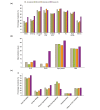Factors associated with severity of atopic dermatitis - a Finnish cross-sectional study
- PMID: 35766133
- PMCID: PMC9796899
- DOI: 10.1111/jdv.18378
Factors associated with severity of atopic dermatitis - a Finnish cross-sectional study
Abstract
Background: Severity-associated factors in atopic dermatitis (AD) have focussed on early onset, concomitant atopic diseases, markers of Th2-shifted inflammation and filaggrin mutations.
Objectives: To investigate factors associated with severe AD in Finnish patients.
Methods: We conducted a single-centre, cross-sectional observational study with 502 AD patients aged 4.79 to 79.90 years (mean 32.08 years). Disease severity was assessed with the Rajka-Langeland severity score and EASI and associated clinical signs were evaluated. Data regarding onset, relatives, atopic and other comorbidities was gathered retrospectively. We investigated total serum IgE-levels, a panel of filaggrin null mutations and functional variants of genes associated with skin barrier defects.
Results: Factors more frequent in severe AD included early onset (P = 0.004, 95%CI 0.000-0.024), male sex (P = 0.002, 95%CI 0.000-0.11), history of smoking (P = 0.012, 95%CI 0.000-0.024), concomitant asthma (P = 0.001, 95%CI 0.000-0.011), palmar hyperlinearity (P = 0.013, 95%CI 0.014-0.059), hand dermatitis (P = 0.020, 95%CI 0.000-0.029) and history of contact allergy (P = 0.042, 95%CI 0.037-0.096). Body mass indices (P < 0.000, 95%CI 0.000-0.011) and total serum IgE-levels (P < 0.000, 95%CI 0.000-0.011) were higher in severe AD. No differences were observed for allergic rhinitis, allergic conjunctivitis, food allergy, peanut allergy, prick positivity, keratosis pilaris, history of herpes simplex infections, filaggrin null mutations and other gene variants.
Conclusions: Severity determinants in Finnish patients seem to be early-onset, male sex, smoking, overweight, concomitant asthma, palmar hyperlinearity, hand dermatitis and high IgE-levels. A sub-typing of patients in relation to confirmed severity determinants may be useful for course prediction, prognosis and targeted AD management.
© 2022 The Authors. Journal of the European Academy of Dermatology and Venereology published by John Wiley & Sons Ltd on behalf of European Academy of Dermatology and Venereology.
Figures


References
-
- Salava A, Perälä M, Juppo M, Pelkonen AS, Mäkelä MJ, Remitz A. Effective treatment of atopic dermatitis in small children significantly improves the quality of life of patients and their families. Eur J Dermatol 2021; 31: 791–797. - PubMed
-
- Chiesa Fuxench ZC, Block JK, Boguniewicz M et al. Atopic dermatitis in America study: a cross‐sectional study examining the prevalence and disease burden of atopic dermatitis in the US adult population. J Invest Dermatol 2019; 139: 583–590. - PubMed
-
- Ständer S. Atopic dermatitis. N Engl J Med 2021; 384: 1136–1143. - PubMed
-
- Gáspár K, Baráth S, Nagy G et al. Regulatory T‐cell subsets with acquired functional impairment: important indicators of disease severity in atopic dermatitis. Acta Derm Venereol 2015; 95: 151–155. - PubMed
-
- Weidinger S, Beck LA, Bieber T, Kabashima K, Irvine AD. Atopic dermatitis. Nat Rev Dis Primers 2018; 4: 1. - PubMed

